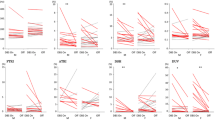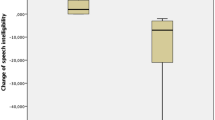Abstract
Speech and voice disorders are one of the most common adverse effects in Parkinson’s disease (PD) patients treated with subthalamic nucleus deep brain stimulation (STN-DBS). However, the pathophysiology of voice and laryngeal dysfunction after STN-DBS remains unclear. We assessed 47 PD patients (22 treated with bilateral STN-DBS (PD-DBS) and 25 treated medically (PD-Med); all patients in both groups matched by age, sex, disease duration, and motor and cognitive function) using the objective and subjective voice assessment batteries (GRBAS scale and Voice Handicap Index), and laryngoscopy. Laryngoscopic examinations revealed that PD-DBS patients showed a significantly higher incidence of incomplete glottal closure (77 vs 48 %; p = 0.039), hyperadduction of the false vocal folds (73 vs 44 %; p = 0.047), anteroposterior hypercompression (50 vs 20 %; p = 0.030) and asymmetrical glottal movement (50 vs 16 %; p = 0.002) than PD-Med patients. On- and off-stimulation assessment revealed that STN-DBS could induce or aggravate incomplete glottal closure, hyperadduction of the false vocal folds, anteroposterior hypercompression, and asymmetrical glottal movement. Incomplete glottal closure and hyperadduction of the false vocal folds significantly correlated with breathiness and strained voice, respectively (r = 0.590 and 0.539). We should adjust patients’ DBS settings in consideration of voice and laryngeal functions as well as motor function.


Similar content being viewed by others
References
Burghaus L, Hilker R, Thiel A, Galldiks N, Lehnhardt FG, Zaro-Weber O et al (2006) Deep brain stimulation of the subthalamic nucleus reversibly deteriorates stuttering in advanced Parkinson’s disease. J Neural Transm 113:625–631
Darley FL, Aronson AE, Brown JR (1969) Differential diagnostic patterns of dysarthria. J Speech Hear Res 12:246–269
Deuschl G, Schade-Brittinger C, Krack P, Volkmann J, Schäfer H, Bötzel K et al (2006) A randomized trial of deep-brain stimulation for Parkinson’s disease. N Engl J Med 355:896–908
Dromey C, Bjarnason S (2011) A preliminary report on disordered speech with deep brain stimulation in individuals with Parkinson’s disease. Parkinsons Dis 2011:796205
Dromey C, Kumar R, Lang AE, Lozano AM (2000) An investigation of the effects of subthalamic nucleus stimulation on acoustic measures of voice. Mov Disord 15:1132–1138
Fytagoridis A, Åström M, Wårdell K, Blomstedt P (2013) Stimulation-induced side effects in the posterior subthalamic area: distribution, characteristics and visualization. Clin Neurol Neurosurg 115:65–71
Gallena S, Smith PJ, Zeffiro T, Ludlow CL (2001) Effects of levodopa on laryngeal and offset in Parkinson disease. J Speech Lang Hear Res 44:1284–1299
Gamboa J, Jimnez-jimnez J, Nieto A, Montojo J, Molina A, Cobeta I (1997) Acoustic voice analysis in patients with Parkinson’s disease treated with dopaminergic drugs. J Voice 11:314–320
Goberman AM, Blomgren M (2008) Fundamental Frequency change during offset and onset of voicing in individuals with Parkinson disease. J Voice 22:178–191
Hanson DG, Gerratt BR, Ward PH (1984) Cinegraphic observations of laryngeal function in Parkinson’s disease. Laryngoscope 94:348–353
Hirano M (1981) Clinical examination of voice. Springer-Verlag, New York
Hughes AJ, Daniel SE, Kilford L, Lees AJ (1992) Accuracy of clinical diagnosis of idiopathic Parkinson’s disease: a clinico-pathological study of 100 cases. J Neurol Neurosurg Psychiatry 55:181–184
Jacobson BH, Johnson A, Grywalski C, Silbergleit A, Jacobson G, Benninger MS (1997) The voice handicap index (VHI): development and validation. Am J Speech Lang Pathol 6:66–70
Karlsson F, Blomstedt P, Olofsson K, Linder J, Nordh E, van Doorn J (2012) Control of phonatory onset and offset in Parkinson patients following deep brain stimulation of the subthalamic nucleus and caudal zona incerta. Park Relat Disord 18:824–827
Klostermann F, Ehlen F, Vesper J, Nubel K, Gross M, Marzinzik F et al (2008) Effects of subthalamic deep brain stimulation on dysarthrophonia in Parkinson’s disease. J Neurol Neurosurg Psychiatry 79:522–529
Lowell SY, Kelley RT, Awan SN, Colton RH, Chan NH (2012) Spectral- and cepstral-based acoustic features of dysphonic, strained voice quality. Ann Otol Rhinol Laryngol 121:539–548
Midi I, Dogan M, Koseoglu M, Can G, Sehitoglu MA, Gunal DI (2008) Voice abnormalities and their relation with motor dysfunction in Parkinson’s disease. Acta Neurol Scand 117:26–34
Moreau C, Pennel-Ployart O, Pinto S, Plachez A, Annic A, Viallet F et al (2011) Modulation of dysarthropneumophonia by low-frequency STN DBS in advanced Parkinson’s disease. Mov Disord 26:659–663
Pinto S, Ozsancak C, Tripoliti E, Thobois S, Limousin-Dowsey P, Auzou P (2004) Treatments for dysarthria in Parkinson’s disease. Lancet Neurol 3:547–556
Pinto S, Gentil M, Krack P, Sauleau P, Fraix V, Benabid AL et al (2005) Changes induced by levodopa and subthalamic nucleus stimulation on parkinsonian speech. Mov Disord 20:1507–1515
Plaha P, Ben-Shlomo Y, Patel NK, Gill SS (2006) Stimulation of the caudal zona incerta is superior to stimulation of the subthalamic nucleus in improving contralateral parkinsonism. Brain 129:1732–1747
Rehncrona S, Johnels B, Widner H, Törnqvist AL, Hariz M, Sydow O (2003) Long-term efficacy of thalamic deep brain stimulation for tremor: double-blind assessments. Mov Disord 18:163–170
Reich MM, Steigerwald F, Sawalhe AD, Reese R, Gunalan K, Johannes S (2015) Short pulse width widens the therapeutic window of subthalamic neurostimulation. Ann Clin Transl Neurol 2:427–432
Schaltenbrand G, Wahren W (1977) Atlas for stereotaxy of the human brain, 2nd edn. Thieme, Stuttgart
Schuepbach WM, Rau J, Knudsen K, Volkmann J, Krack P, Timmermann L et al (2013) Neurostimulation for Parkinson’s disease with early motor complications. N Engl J Med 368:610–622
Skodda S, Grönheit W, Schlegel U, Südmeyer M, Schnitzler A, Wojtecki L (2014) Effect of subthalamic stimulation on voice and speech in Parkinson’s disease: for the better or worse? Front Neurol 4:218
Smith ME, Ramig LO, Dromey C, Perez KS, Samandari R (1995) Intensive voice treatment in Parkinson disease: laryngostroboscopic findings. J Voice 9:453–459
Steep C (2014) Relative fundamental frequency during vocal onset and offset in older speakers with and without Parkinson’s disease. J Acoust Soc Am 133:1637–1643
Tanaka Y, Tsuboi T, Watanabe H, Kajita Y, Fujimoto Y, Ohdake R et al (2015) Voice features of Parkinson’s disease patients with subthalamic nucleus deep brain stimulation. J Neurol 262:1173–1181
Tomlinson CL, Stowe R, Patel S, Rick C, Gray R, Clarke CE (2010) Systematic review of levodopa dose equivalency reporting in Parkinson’s disease. Mov Disord 25:2649–2653
Tommasi G, Krack P, Fraix V, Le Bas JF, Chabardes S, Benabid AL et al (2008) Pyramidal tract side effects induced by deep brain stimulation of the subthalamic nucleus. J Neurol Neurosurg Psychiatry 79:813–819
Tripoliti E, Zrinzo L, Martinez-Torres I, Frost E, Pinto S, Foltynie T et al (2011a) Effects of subthalamic stimulation on speech of consecutive patients with Parkinson disease. Neurology 76:80–86
Tripoliti E, Strong L, Hickey F, Foltynie T, Zrinzo L, Candelario J et al (2011b) Treatment of dysarthria following subthalamic nucleus deep brain stimulation for Parkinson’s disease. Mov Disord 26:2434–2436
Tripoliti E, Limousin P, Foltynie T, Candelario J, Aviles-Olmos I, Hariz MI et al (2014) Predictive factors of speech intelligibility following subthalamic nucleus stimulation in consecutive patients with Parkinson’s disease. Mov Disord 29:532–538
Tsuboi T, Watanabe H, Tanaka Y, Ohdake R, Yoneyama N, Hara K, et al. (2015) Distinct phenotypes of speech and voice disorders in Parkinson’s disease after subthalamic nucleus deep brain stimulation. J Neurol Neurosurg Psychiatry. doi:10.1136/jnnp-2014-308043
Wertheimer J, Gottuso AY, Nuno M, Walton C, Duboille A, Tuchman M et al (2014) The impact of STN deep brain stimulation on speech in individuals with Parkinson’s disease: the patient’s perspective. Parkinsonism Relat Disord 20:1065–1070
Acknowledgments
This study was supported by Health and Labor Sciences Research grants for research on measures for intractable diseases and comprehensive research on aging and health from the Ministry of Health, Labor and Welfare, Japan. The authors would like to thank Enago (www.enago.jp) for the English language review.
Author information
Authors and Affiliations
Corresponding author
Ethics declarations
Conflict of interest
None.
Electronic supplementary material
Below is the link to the electronic supplementary material.
Segment 1. Patient 1 had moderate incomplete glottal closure, mild hyperadduction of the false vocal folds, and asymmetrical glottal movement in the on-stimulation condition. Thirty minutes after stopping stimulation, incomplete glottal closure was marginally ameliorated and asymmetrical glottal movement disappeared. (MP4 16520 kb)
Segment 2. Patient 2 had moderate incomplete glottal closure, severe hyperadduction of the false vocal folds, anteroposterior hypercompression, and asymmetrical glottal movement in the on-stimulation condition. Thirty minutes after stopping stimulation, incomplete glottal closure and anteroposterior hypercompression disappeared and hyperadduction of the false vocal folds slightly improved. (MP4 18507 kb)
Segment 3. Patient 6 had severe incomplete glottal closure, severe hyperadduction of the false vocal folds, anteroposterior hypercompression, and asymmetrical glottal movement in the on-stimulation condition. Incomplete glottal closure, hyperadduction of the false vocal folds, and anteroposterior hypercompression disappeared with off-stimulation of the left-side DBS. (MP4 18005 kb)
Rights and permissions
About this article
Cite this article
Tsuboi, T., Watanabe, H., Tanaka, Y. et al. Characteristic laryngoscopic findings in Parkinson’s disease patients after subthalamic nucleus deep brain stimulation and its correlation with voice disorder. J Neural Transm 122, 1663–1672 (2015). https://doi.org/10.1007/s00702-015-1436-y
Received:
Accepted:
Published:
Issue Date:
DOI: https://doi.org/10.1007/s00702-015-1436-y




